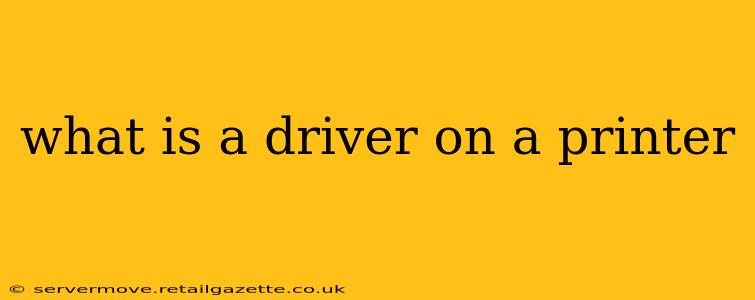What is a Printer Driver? Unlocking the Secrets of Your Printer's Communication
A printer driver is the unsung hero that allows your computer to communicate with your printer. Think of it as the translator between your computer's operating system (like Windows or macOS) and the printer's hardware. Without the correct driver, your computer simply won't know how to send print jobs to your printer, no matter how much ink it has or how shiny it looks.
It's a crucial piece of software that provides the instructions your operating system needs to understand the printer's specific capabilities, like:
- Print Resolution: The driver dictates the quality of the printed output (dots per inch or DPI). Higher DPI means sharper images and clearer text.
- Paper Size and Type: It tells the system what sizes and types of paper your printer can handle, ensuring the correct settings are used for each print job.
- Color Settings: The driver manages color profiles, enabling accurate color reproduction based on the printer's capabilities and the document's color mode.
- Duplex Printing (Double-Sided): If your printer supports double-sided printing, the driver facilitates this function.
- Special Features: Many printers offer unique features, such as borderless printing, specific paper handling options, or specialized printing modes. The driver makes these features accessible from your computer.
Why is a Printer Driver Important?
Imagine trying to speak to someone who only understands a completely different language. That's essentially what happens without a printer driver. Your computer sends print data, but the printer can't understand it. The driver acts as the interpreter, converting the data into a language the printer understands so that it can correctly process and print your document.
What Happens When a Printer Driver is Missing or Outdated?
If you're missing or using an outdated printer driver, you might experience a variety of issues, including:
- Printing Errors: The most common problem is the inability to print altogether or encountering unexpected errors during the printing process.
- Poor Print Quality: Outdated drivers might not utilize the printer's full capabilities, leading to blurry text or faded colors.
- Incompatibility Issues: Using the wrong or outdated driver can lead to incompatibility between your printer and your computer's operating system.
- Missing Features: Some printer features might be unavailable if the driver doesn't support them.
How to Install or Update a Printer Driver?
Installing or updating a printer driver is generally straightforward. The process usually involves:
- Connecting the Printer: Connect your printer to your computer (either via USB or network connection).
- Automatic Driver Installation (Recommended): Most operating systems will automatically detect your printer and install the appropriate driver.
- Manual Driver Installation: If automatic installation fails, you can download the latest driver from the manufacturer's website and install it manually. This usually involves finding your printer model on their support page and downloading the correct driver for your operating system.
How Do I Know if I Need a New Printer Driver?
You might need a new printer driver if you experience any of the problems mentioned above, or if you've recently:
- Installed a New Operating System: A new operating system might require a new driver.
- Upgraded Your Printer's Firmware: Firmware upgrades sometimes necessitate a driver update for optimal performance.
- Purchased a New Printer: This is an obvious scenario requiring driver installation.
By understanding the role of printer drivers, you can troubleshoot printing issues more effectively and ensure your printer consistently delivers high-quality output. Remember to always check the manufacturer's website for the latest driver updates to maximize your printer's performance and functionality.
